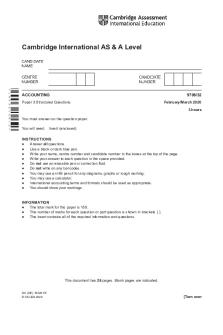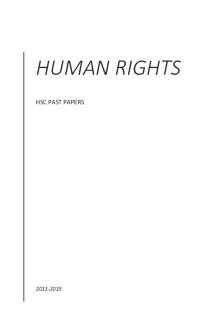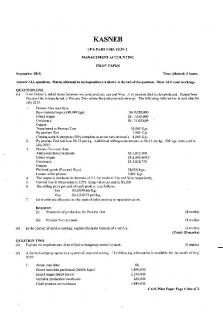N5 Biology all 2018 - past papers PDF

| Title | N5 Biology all 2018 - past papers |
|---|---|
| Author | Sara Wisniewska |
| Course | Clinical Medicine |
| Institution | University of Glasgow |
| Pages | 48 |
| File Size | 1.6 MB |
| File Type | |
| Total Downloads | 10 |
| Total Views | 128 |
Summary
past papers
...
Description
N5 X807/75/02
National Qualications 2018 Biology Section 1 — Questions
TUESDAY, 15 MAY 1:00 PM – 3:30 PM
Instructions for the completion of Section 1 are given on page 02 of your question and answer booklet X807/75/01. Record your answers on the answer grid on page 03 of your question and answer booklet. Before leaving the examination room you must give your question and answer booklet to the Invigilator; if you do not, you may lose all the marks for this paper.
©
*X8077502* A/HTP
SECTION 1
1.
The diagram shows a cell with a section of the cell membrane magnified. Magnified section
molecule X
Molecule X is
2.
A
phospholipid
B
protein
C
cellulose
D
starch.
The diagram shows an experiment in which a model cell was placed in a sucrose solution.
5% sucrose solution
15% sucrose solution Model cell
At the start of the experiment the model cell weighed 25 g and at the end it weighed 30 g. What was the percentage increase in mass? A
5·0%
B
16·7%
C
20·0%
D
83·3%
page 02
3.
Glucose molecules in low concentration in the kidney have to be moved into the bloodstream, where there is a higher concentration of glucose. The process responsible for this action is
4.
5.
A
osmosis
B
diffusion
C
passive transport
D
active transport.
Which of the following represents the sequence of events in the production of a protein from the genetic code? A
DNA
amino acids
mRNA
protein
B
DNA
mRNA
amino acids
protein
C
mRNA
DNA
amino acids
protein
D
amino acids
DNA
mRNA
protein
Which of the following are all types of proteins? A
Hormones, enzymes and nitrates
B
Antibodies, enzymes and plasmids
C
Hormones, receptors and antibodies
D
Receptors, antibodies and nitrates
[Turn over
page 03
6.
The flowchart represents some of the stages of genetic engineering.
identify required gene from source chromosome
extract plasmid from bacterial cell
extract required gene
stage X
insert plasmid into host bacterial cell to produce a GM organism
A suitable description of stage X would be A
insert bacterial plasmid into required gene
B
insert bacterial plasmid into source chromosome
C
insert required gene into host bacterial cell
D
insert required gene into bacterial plasmid.
page 04
7.
The diagram shows an experiment which can be used to find the energy content of different foods. Each food was completely burned and the energy content was estimated by the rise in temperature of the water.
thermometer
clamp
water spoon burning food
The reliability of this experiment could be improved by
8.
A
burning each food for the same length of time
B
repeating the experiment with each food several times
C
removing the thermometer from the tube to read it accurately
D
repeating the experiment using a different food each time.
The apparatus shown was used to investigate the rate of respiration in yeast at 20 °C.
stopper layer of oil indicator solution
5% glucose solution with yeast
Which of the following changes would cause a decrease in the rate of respiration of the yeast? A
Increase the thickness of the layer of oil by 1 mm.
B
Increase the temperature of the glucose solution by 1 °C.
C
Decrease the concentration of the glucose solution by 1%.
D
Decrease the volume of indicator solution by 1 cm3.
[Turn over
page 05
9.
The diagram shows some of the structures found in a reflex arc.
nerve ending
P
cross-section of spinal cord
Q
R
muscle
Which row in the table identifies P, Q and R?
10.
Motor neuron
Sensory neuron
Inter neuron
A
Q
R
P
B
Q
P
R
C
R
P
Q
D
P
R
Q
The diagram represents a section through the brain. G
H
Which of the following links a letter to its correct structure and function? A
G is the cerebrum and is the site of reasoning and memory.
B
G is the cerebellum and is the site of reasoning and memory.
C
H is the medulla and controls muscle coordination.
D
H is the cerebellum and controls breathing and heart rate.
page 06
Questions 11 and 12 refer to the following flow diagram related to blood glucose regulation.
organ X
releases hormone Y
acts on organ Z
promotes conversion of glycogen to glucose
11.
12.
Which row in the table identifies organ X and hormone Y?
Organ X
Hormone Y
A
Liver
Insulin
B
Liver
Glucagon
C
Pancreas
Insulin
D
Pancreas
Glucagon
Specialised cells allow organ Z to respond to hormone Y. This is because the surface of the cells in organ Z have complementary A
synapses
B
neurons
C
effectors
D
receptors.
[Turn over
page 07
13.
14.
15.
An increase in which of the following factors would decrease the rate of transpiration in plants? A
Wind speed
B
Humidity
C
Surface area
D
Temperature
Which of the following statements about blood cells is false? A
White blood cells are part of the immune system.
B
Phagocytes are a type of white blood cell.
C
Red blood cells contain haemoglobin.
D
Phagocytes transport nutrients around the body.
Which row in the table identifies how lymphocytes destroy pathogens?
Antibody production
Phagocytosis
A
Yes
No
B
No
No
C
No
Yes
D
Yes
Yes
page 08
16.
The following key can be used to identify the different components of blood. 1.
2.
3.
Nucleus absent
go to 2
Nucleus present
go to 3
Diameter greater than 0·005 mm
red blood cell
Diameter less than 0·005 mm
platelet
Nucleus is circular
lymphocyte
Nucleus is not circular
macrophage
Use the key above to identify which of the diagrams represents a platelet.
17.
18.
A
B
C
D
0∙02 mm
0∙02 mm
0∙008 mm
0∙003 mm
Which of the following statements is true of villi? A
Blood capillaries absorb glycerol and amino acids.
B
Blood capillaries absorb glucose and fatty acids.
C
Lacteals absorb glycerol and fatty acids.
D
Lacteals absorb glucose and amino acids.
An ecosystem consists of abiotic factors plus a A
community and its biodiversity
B
population and its biodiversity
C
population and its habitat
D
community and its habitat.
[Turn over
page 09
19.
The diagram shows part of a food web. hawk
thrush
snail
caterpillar
slug
oak tree
A chemical was used to control the number of slugs. Which of the following could be a result of a large decrease in slug numbers? A
An increase in snails.
B
An increase in hawks.
C
A decrease in caterpillars.
D
A decrease in oak trees.
page 10
20.
The diagrams show an investigation into seed germination. Tube 1
Tube 2
10 seeds
Tube 3
10 seeds
20 seeds
dry cotton wool 5 °C
wet cotton wool 20 °C
dry cotton wool 5 °C
Tube 4
Tube 5
Tube 6
20 seeds
dry cotton wool 20 °C
10 seeds
wet cotton wool 5 °C
20 seeds
wet cotton wool 20 °C
For a valid conclusion to be drawn, which two tubes should be compared to show the effect of temperature on germination? A
1 and 3
B
3 and 6
C
2 and 5
D
4 and 6
[Turn over
page 11
21.
The diagram represents a pyramid of energy.
X
There is less energy at level X in the pyramid because
22.
A
there are fewer organisms at each level in the food chain
B
the organisms at level X are very small
C
energy is lost at each level in the food chain
D
energy is stored in each level and not passed on.
Mutations result in changes to genetic material. Which of the following is not true of mutations?
23.
A
Radiation can increase their rate.
B
They always have a harmful effect.
C
Genetic material is affected at random.
D
New alleles may be produced.
Natural selection occurs when there are selection pressures. Which of the following could be a result of selection pressures? A
Organisms with favourable alleles survive and reproduce.
B
Organisms with new alleles always have an advantage.
C
All alleles in a population increase in frequency.
D
All alleles in a population decrease in frequency.
page 12
24.
Pesticides sprayed onto crops can get into food chains. The following statements refer to stages in this process. J
Pesticides are absorbed by plants.
K
Pesticides build up in animals.
L
Plants are eaten by animals.
Identify the order of steps by which pesticides could reach lethal levels in the bodies of animals.
25.
Step 1
Step 2
Step 3
A
J
K
L
B
L
J
K
C
L
K
J
D
J
L
K
Which row in the table identifies biotic and abiotic factors which can affect a population?
Biotic factors
Abiotic factors
A
grazing and predation
pH and temperature
B
predation and temperature
pH and grazing
C
pH and temperature
grazing and predation
D
pH and grazing
predation and temperature
[END OF SECTION 1. NOW ATTEMPT THE QUESTIONS IN SECTION 2 OF YOUR QUESTION AND ANSWER BOOKLET.]
page 13
[BLANK PAGE] DO NOT WRITE ON THIS PAGE
page 14
[BLANK PAGE] DO NOT WRITE ON THIS PAGE
page 15
[BLANK PAGE] DO NOT WRITE ON THIS PAGE
page 16
FOR OFFICIAL USE
N5
National Qualications 2018
Mark
Biology Section 1 — Answer Grid and Section 2
X807/75/01 TUESDAY, 15 MAY
*X8077501*
1:00 PM – 3:30 PM
Fill in these boxes and read what is printed below. Full name of centre
Town
Forename(s)
Date of birth Day Month
Surname
Year
Number of seat
Scottish candidate number
Total marks — 100 SECTION 1 — 25 marks Attempt ALL questions. Instructions for the completion of Section 1 are given on page 02. SECTION 2 — 75 marks Attempt ALL questions. Write your answers clearly in the spaces provided in this booklet. Additional space for answers and rough work is provided at the end of this booklet. If you use this space you must clearly identify the question number you are attempting. Any rough work must be written in this booklet. Score through your rough work when you have written your final copy. Use blue or black ink. Before leaving the examination room you must give this booklet to the Invigilator; if you do not, you may lose all the marks for this paper. ©
*X807750101* A/HTP
SECTION 1 — 25 marks The questions for Section 1 are contained in the question paper X807/75/02. Read these and record your answers on the answer grid on page 03 opposite. Use blue or black ink. Do NOT use gel pens or pencil. 1.
The answer to each question is either A, B, C or D. Decide what your answer is, then fill in the appropriate bubble (see sample question below).
2.
There is only one correct answer to each question.
3. Any rough working should be done on the additional space for answers and rough work at the end of this booklet. Sample question The thigh bone is called the A
humerus
B
femur
C
tibia
D
fibula.
The correct answer is B — femur. The answer B bubble has been clearly filled in (see below). A
B
C
D
Changing an answer If you decide to change your answer, cancel your first answer by putting a cross through it (see below) and fill in the answer you want. The answer below has been changed to D. A
B
C
D
If you then decide to change back to an answer you have already scored out, put a tick (3) to the right of the answer you want, as shown below: A
B
C
D
A
B
C
D
or
*X807750102* page 02
SECTION 1 — Answer Grid
*OBJ25AD1* A
B
C
D
1 2 3 4 5 6 7 8 9 10 11 12 13 14 15 16 17 18 19 20 21 22 23 24 25
*X807750103* page 03
[Turn over
[BLANK PAGE] DO NOT WRITE ON THIS PAGE
*X807750104* page 04
MARKS
DO NOT WRITE IN THIS MARGIN
SECTION 2 — 75 marks Attempt ALL questions
1.
(a) The diagram shows a typical animal cell and some of its structures. Cytoplasm Mitochondrion
Ribosomes
Cell membrane
2
Choose two of the structures labelled and state their functions. 1
Structure Function
2
Structure Function
(b) The field of view of a light microscope measures 2 mm in diameter. 20 plant cells were counted in a line across the diameter. 1 mm = 1000 micrometres Calculate the average size of a cell in micrometres.
1
Space for calculation
micrometres
*X807750105* page 05
[Turn over
MARKS
2.
A student examined plant and animal cells using a microscope. Animal cell
Plant cell
The animal and plant cells were placed in solutions of different salt concentrations. After several minutes a sample of cells was taken from each solution and examined. One cell from each solution is shown. 1
2
3
4
5
6
(a) Changes in the cells were due to osmosis. Explain why osmosis is described as a passive process.
(b) Identify the animal cell shown which had been placed in a solution of higher salt concentration than its cell contents.
1
1
Cell number (c) State the term used to describe the condition of cell 6.
1
(d) Cells 3 and 4 had been placed in solutions which were both of the same concentration. Explain why the results observed were different.
*X807750106* page 06
2
DO NOT WRITE IN THIS MARGIN
MARKS
3.
The diagram represents part of a DNA molecule.
Strand of DNA Strand of DNA
(a)
(i) Give the term which describes the shape of a DNA molecule as shown in the diagram.
(ii) Describe the way in which the DNA strands are linked together.
(b) Name the organelle in animal cells which stores the DNA.
page 07
1
1
[Turn over
*X807750107*
1
DO NOT WRITE IN THIS MARGIN
MARKS
4.
The diagrams represent stages in an enzyme-controlled reaction.
Stage 1
Stage 2
Stage 3
(a) Enzymes are involved in two types of reaction. Identify the type of reaction shown in the diagrams above.
(b) Describe the events occurring in the enzyme reaction shown.
*X807750108* page 08
1
3
DO NOT WRITE IN THIS MARGIN
MARKS
5.
(a) The table shows information about two types of respiration in animal cells. Tick the boxes in the table to indicate whether the statements apply to aerobic respiration, fermentation or both.
2
Type of respiration Statement
Aerobic
Fermentation
Oxygen is required Pyruvate is formed Lactate is formed Carbon dioxide is formed
(b) ATP is an energy-rich molecule formed by respiration. 1
Name a cellular process which requires energy from ATP.
[Turn over
*X807750109* page 09
DO NOT WRITE IN THIS MARGIN
6.
An investigation was carried out into the effect of pH on the activity of the enzyme pepsin. A Petri dish was filled with cloudy protein agar. Six holes wer...
Similar Free PDFs

N5 Biology all 2018 - past papers
- 48 Pages

9706 past papers
- 28 Pages

Past exams papers 2
- 10 Pages

Past Papers Human Rights
- 14 Pages

AC100 - Past exam papers
- 15 Pages

Management Accounting Past Papers
- 38 Pages

CRIMINAL LAW PAST PAPERS
- 4 Pages

Topical past papers
- 27 Pages

Accounting 100 past papers
- 2 Pages

acca sbr past papers practice
- 49 Pages

All previous exam papers
- 1 Pages

All-Question Papers
- 52 Pages
Popular Institutions
- Tinajero National High School - Annex
- Politeknik Caltex Riau
- Yokohama City University
- SGT University
- University of Al-Qadisiyah
- Divine Word College of Vigan
- Techniek College Rotterdam
- Universidade de Santiago
- Universiti Teknologi MARA Cawangan Johor Kampus Pasir Gudang
- Poltekkes Kemenkes Yogyakarta
- Baguio City National High School
- Colegio san marcos
- preparatoria uno
- Centro de Bachillerato Tecnológico Industrial y de Servicios No. 107
- Dalian Maritime University
- Quang Trung Secondary School
- Colegio Tecnológico en Informática
- Corporación Regional de Educación Superior
- Grupo CEDVA
- Dar Al Uloom University
- Centro de Estudios Preuniversitarios de la Universidad Nacional de Ingeniería
- 上智大学
- Aakash International School, Nuna Majara
- San Felipe Neri Catholic School
- Kang Chiao International School - New Taipei City
- Misamis Occidental National High School
- Institución Educativa Escuela Normal Juan Ladrilleros
- Kolehiyo ng Pantukan
- Batanes State College
- Instituto Continental
- Sekolah Menengah Kejuruan Kesehatan Kaltara (Tarakan)
- Colegio de La Inmaculada Concepcion - Cebu



